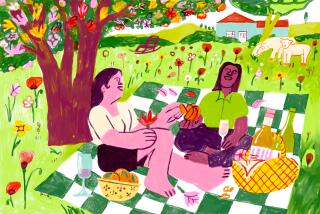And now for some red wines to pair with fall’s bountiful food
- Share via
Even if autumn in Los Angeles is more theoretical than actual, it is still a time when days are diminished and nights are clear, when roasts and braises reenter the dinner repertoire and the transition to the season’s produce — squashes, apples, root vegetables, an earthy spectrum of cruciferous greens — calls for an arsenal of autumnal red wines to pour.
So these aren’t so much wines of the week as wines of the moment, and the categories amount to rationales. But the objective is the same: to provide you with a small retinue of affordable, medium-bodied, unheavy wines that will usher in the change of seasons.
The autumn flavor of Loire
Some wines not only evoke an autumnal mood, they actually smell, taste and feel like the season, none more than reds from France’s Loire Valley. Here, the red varieties — Grolleau, Pineau d’Aunis, Cot, Gamay, Pinot Noir and especially Cabernet Franc — possess a remarkably moody palette of scents and flavors: bramble, leaf piles, forest floor, dried herbs, wood smoke and pine. Some blends in this repertoire really strike the mood, such as Philippe Tessier’s Cheverny, a blend of Gamay and Cot, and La Grange Tiphaine’s “Ad Libitum,” a blend of Cot, Gamay and Cabernet Franc.
But there’s nothing like Cabernet Franc from the appellations that specialize in it: Chinon, Bourgueil, Saumur-Champigny and others, fragrant, sappy reds with a hint of herbaceousness. The 2015 Trinch! is a light-bodied Bourgueil from Catherine and Pierre Breton — the word trinch! is pinched from Rabelais, and means “cheers!” — and has a smoky, pink peppercorn scent, fresh purple plum flavors and clean, mineral tannins (around $27 at K&L and Lincoln Fine Wines).
Young wines for a harvest party
Red wine rushed to market, in the tradition of Beaujolais Nouveau, seems gimmicky, hygienically suspect and probably a bad idea for good wine. But historically, Nouveau was among the first of France’s wines to get poured after harvest and became an end of season harbinger, a wine with which to wash down the farm’s final bounty, thick and frothy, mirthful and intoxicating.
Young Beaujolais makes sense for autumn meals, but consider the many California winemakers who are making equivalent American vins de glug, young juicy reds built for the short haul. There’s Pax Mahle’s blend Soif, Stolpman’s 2015 Carbonic Sangiovese and Broc Cellars’ Carbonic Carignan, fermented using a whole berry maceration that softens tannins and lifts the dense fruit, resulting in a wine that fairly bursts with red fruit flavors (around $27, at Domaine LA).
Cool-climate Syrah
For anything oven roasted — beef, chicken, lamb shoulders and haunches — you can safely up the tannic payload in your reds, many of which fit the autumnal theme. But I’m going to recommend cool-climate American Syrah. Few wines are better suited for roasted or braised red meats, and for lamb, there’s none better. Cool-climate iterations of the variety have an extraordinary array of aromatics that feel very fall-like, whether exhibiting garrigue herb accents (think rosemary, thyme, lavender) or something more sanguine (think smoked or cured meat), supported by tannins that are unusually fine and pliant, firm enough for food but sensual on their own. Consider the Piedrasassi from Santa Barbara County (about $35), Arnot Roberts’ Sonoma Coast bottling (about $40), and Samsara’s reds (about $45).
Though probably the most accessible and the most available of all of these is the Sta Rita Hills bottling of Melville’s 2013 Syrah, called “Verna’s.” Year in and year out, it is effortlessly complex, a wine that tastes like a potpourri of black pepper and violets, and is a steal (at Woodland Hills, Wine House, and Wine Country, about $28).
More to Read
Eat your way across L.A.
Get our weekly Tasting Notes newsletter for reviews, news and more.
You may occasionally receive promotional content from the Los Angeles Times.









